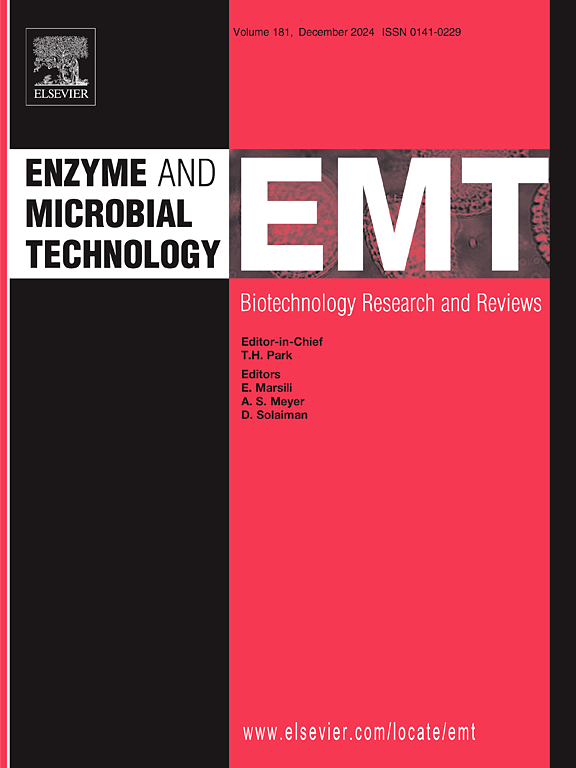Unlocking lignin valorisation: Oxyfunctionalization of lignin dimer model compounds by unspecific peroxygenases
IF 3.7
3区 生物学
Q2 BIOTECHNOLOGY & APPLIED MICROBIOLOGY
引用次数: 0
Abstract
Lignin is an abundantly available biopolymer composed of three structural units, linked by a complex network of bonds, including a high proportion of β-O-4 ether linkages. As a renewable carbon source, it can be depolymerised into a variety of small aromatic compounds such as monophenols. Enzymatic bioprocessing offers a promising alternative to traditional chemical lignin degradation strategies, potentially producing value-added compounds, such as monoaromatics. Unspecific peroxygenases (UPOs) are promising enzymes for lignin bioprocessing due to their ability to catalyse aromatic oxidation and demethylation reactions, which are critical for lignin valorisation. In this study, thirteen different UPOs were evaluated for their oxidation potential with two lignin dimer model compounds, guaiacylglycerol-β-guaiacyl ether and veratrylglycerol-β-guaiacyl ether. Both compounds were successfully processed, yielding a wide range of products, e.g., via Cα-oxidation, demethylation, and bond cleavage reactions. Notably, the cleavages frequently occurred at the Cβ–O ether bond, a major linkage between the lignin monomers, being beneficial for lignin degradation and subsequent valorisation. Some of the identified products, such as vanillin, are of interest either as valuable end-products or as precursors for further conversion into specialty chemicals.
解锁木质素增值:木质素二聚体模型化合物通过非特异性过加氧酶的氧化功能化
木质素是一种丰富的生物聚合物,由三个结构单元组成,由一个复杂的键网络连接,包括高比例的β-O-4醚键。作为一种可再生的碳源,它可以解聚成各种小芳香化合物,如单酚类化合物。酶生物处理为传统的化学木质素降解策略提供了一个有希望的替代方案,可能产生增值化合物,如单芳烃。非特异性过氧酶(UPOs)具有催化芳香氧化和去甲基化反应的能力,是木质素生物加工的重要酶类。本研究用两种木质素二聚体模型化合物,愈创木酰甘油-β-愈创木酰醚和戊基甘油-β-愈创木酰醚,评价了13种不同的UPOs的氧化电位。这两种化合物都被成功地加工,产生了广泛的产品,例如通过c - α-氧化,去甲基化和键裂解反应。值得注意的是,劈裂经常发生在c - β - o醚键上,这是木质素单体之间的主要连接,有利于木质素的降解和随后的增值。一些已确定的产品,如香兰素,是有价值的最终产品或作为进一步转化为特种化学品的前体。
本文章由计算机程序翻译,如有差异,请以英文原文为准。
求助全文
约1分钟内获得全文
求助全文
来源期刊

Enzyme and Microbial Technology
生物-生物工程与应用微生物
CiteScore
7.60
自引率
5.90%
发文量
142
审稿时长
38 days
期刊介绍:
Enzyme and Microbial Technology is an international, peer-reviewed journal publishing original research and reviews, of biotechnological significance and novelty, on basic and applied aspects of the science and technology of processes involving the use of enzymes, micro-organisms, animal cells and plant cells.
We especially encourage submissions on:
Biocatalysis and the use of Directed Evolution in Synthetic Biology and Biotechnology
Biotechnological Production of New Bioactive Molecules, Biomaterials, Biopharmaceuticals, and Biofuels
New Imaging Techniques and Biosensors, especially as applicable to Healthcare and Systems Biology
New Biotechnological Approaches in Genomics, Proteomics and Metabolomics
Metabolic Engineering, Biomolecular Engineering and Nanobiotechnology
Manuscripts which report isolation, purification, immobilization or utilization of organisms or enzymes which are already well-described in the literature are not suitable for publication in EMT, unless their primary purpose is to report significant new findings or approaches which are of broad biotechnological importance. Similarly, manuscripts which report optimization studies on well-established processes are inappropriate. EMT does not accept papers dealing with mathematical modeling unless they report significant, new experimental data.
 求助内容:
求助内容: 应助结果提醒方式:
应助结果提醒方式:


